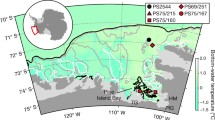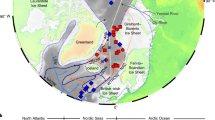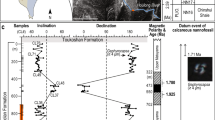Abstract
Various models of surface and deep-water circulation in the Norwegian-Greenland Sea (NGS) have been proposed for the last two glacial to interglacial transitions. Although much progress has been made in understanding the sedimentary response to climatic and oceanographic changes, conflicting interpretations have been developed. To clarify some of these discrepancies and to test or modify the existing circulation concepts, a multiparameter approach is applied, combining sedimentological, micropaleontological, organic-geochemical and isotopic methods. On the basis of indicative properties a combined litho- and organofacies concept is developed and calibrated with modern depositional settings beneath different surface water masses. Sedimentary regimes are then derived for glacial and deglacial settings.
Atlantic water intrusions in the NGS reveal complex and highly dynamic patterns for the last two glacial and interglacial periods, with repetitive inflows during Isotope Stage 6 and a high variability in Isotope Stage 5. Specific facies patterns show maximum extensions of Atlantic Water intrusions during the climatic highstands 5.5.1, 5.3 and 5.1 and narrowest intrusions in the cool phases 5.4 and most pronounced in 5.2. In contrast, different glacio-marine depositional regimes depict variable sea ice coverage and supply of ice-rafted debris. Most conspicuous are short-term depositional events marked by diamictons, which are related to the high instabilities of continental ice sheets. Some of the diamictons seem to occur contemporaneously with Heinrich layers H1 and H2. The probable temporal and obvious phenomenological concidence of Heinrich layers and NGS diamictons suggests a common trigger mechanism which caused an almost simultaneous disintegration of huge continental ice masses along the shelves of North America and the eastern margin of the NGS.
A previous estuarine circulation model claims regional upwelling along the eastern margin of the NGS for specific periods of the last deglaciation. The organic character of sediments covering the same time intervals show a clear predominance of reworked fossil organic matter and thus does not support the estuarine model.
Similar content being viewed by others
References
Bathmann UV, Peinert R, Noji T, von Bodungen B (1990) Pelagic origin and fate of sedimenting particles in the Norwegian Sea. Prog Oceanog 24:117–125
Baumann K-H (1990) Veränderlichkeit der Coccolithophoridenflora des Europäischen Nordmeeres im Jungquartär. Ber Sonderforschungsbereich 313, Univ Kiel, 22:1–146
Baumann K-H, Matthiessen J (1992) Variations in surface water mass conditions in the Norwegian Sea: evidence from Holocene coccolith and dinoflagellate cyst assemblages. Mar Micropaleontol 20:129–146
Baumann K-H, Lackschewitz K, Erlenkeuser H, Henrich R, Ringer B (1993) Late Quaternary calcium carbonate sedimentation and terrigenous input along the east Greenland continental margin. Mar Geol 114:13–36
Belanger PE (1982) Paleoceanography of the Norwegian Sea during the past 130000 yrs.: coccolithophorid and foraminiferal data. Boreas 11:26–36
Bischof J, Koch J, Kubisch M, Spielhagen RF, Thiede J (1990) Nordic Seas surface ice drift reconstructions: evidence from ice rafted coal fragments during oxygen isotope stage 6. In: Dowdeswell JA, Scourse JD (eds) Glacimarine Environments: Processes and Sediments. Spec Publ Geol Soc, London, 53:235–251
Blaume F (1992) Hochakkumulationsgebiete am Norwegischen Kontinentalhang: Sedimentologische Abbilder Topographic geführter Strömungsmuster. Ber Sonderforschungsbereich 313, Univ Kiel, 36:1–150
Bond G, Heinrich H, Broecker W, Labeyrie J, McManus L, Andrews J, Huon S, Jantschik R, Clasen S, Simet C, Tedesco K, Klas M, Bonani G, Ivy S (1992) Evidence for massive discharges of icebergs into the North Atlantic ocean during the last glacial period. Nature 360:245–249
Boyle EA, Keigwin LD (1987) Deep circulation of the North Atlantic over the last 200000 years: geochemical evidence. Nature 218:784–786
Bubnoff Sv (1952) Fennosarmatia. Geologische Analyse des europäischen Kerngebietes. Akademie-Verlag, Berlin, pp 450
Bugge T, Knarud R, Mørk A (1984) Bedrock geology on the midNorwegian continental shelf. In: Norwegian Geological Society (ed) Petroleum Geology of the North European Margin. Graham and Trotman, London, pp 271–283
Carstens T (1988) Verteilung planktischer Foraminiferen in Oberflächenwässern der Fram-Straße, Nordatlantik. Unpublished Thesis, Univ Bremen, pp 1–55
CLIMAP (1981) Maps of northern and southern hemisphere continental ice, sea ice, and sea surface temperatures in August for the modern and the last glacial maximum. Geol Soc Am Map Chart Ser MC-36
Combaz A, Bellet J, Poulain D, Caratini C, Tissot C (1974) Étude microscopique de la matière organique de sédiments quaternaires de Mer de Norvege. In: CNRS (ed) Orgon I Mer de Norvège. Paris, 139–175
Corliss BH, Martinson DG, Keffer T (1986) Late Quaternary deep-ocean circulation. Geol Soc. Am Bull 97:1106–1121
Elverhøi A, Lauritzen Ø (1984) Bedrock geology of the northern Barents Sea (west of 35° E) as inferred from the overlying Quaternary deposits. Norsk Polarinst Skr 180:5–16
Gard G, Backman J (1990) Synthesis of Arctic and Sub-Arctic coccolith biochronology and history of North Atlantic drift water influx during the last 500000 years. In: Bleil U, Thiede J (eds) Geological History of the Polar Oceans: Arctic versus Antarctic. NATO ASI Ser C, 308. Kluwer Academic, Dordrecht, pp 417–436
Gerlach SA, Graf G (1991) Meteor Reise Nr. 13 vom 6. Juli-24. August 1990, Europäisches Nordmeer. Meteor-Berichte Nr. 91–2:1–217
Gerlach SA, Thiede J, Graf G, Werner F (1986) Forschungsschiff Meteor, Reise 2 vom 19. Juni his 16. Juli 1986; Forschungsschiff Poseidon, Reise 128 vom 7. Mai his 8. Juni 1986. Ber Sonderforschungsbereich 313, Univ Kiel, 4:1–140
Haake F-W, Pflaumann U (1989) Late Pleistocene foraminiferal stratigraphy on the Vøring Plateau. Boreas 18:343–356
Hebbeln D, Wefer G (1991) Effects of ice coverage and ice rafted material on sedimentation in the Fram Strait. Nature 350:409–411
Heinrich H (1988) Origin and consequences of cyclic ice rafting in the northeast Atlantic Ocean during the past 130000 years. Quat Res 29:142–152
Henrich R (1988) Sedimentologisch-fazielle Untersuchungen an glacial/interglazialen and präglazialen Ablagerungen des Europäischen Nordmeeres. Ber Sonderforschungsbereich 313, Univ Kiel
Henrich R (1989) Glacial/interglacial cycles in the Norwegian Sea: sedimentology, paleoceanography, and evolution of Late Pliocene to Quaternary northern hemisphere climate. In: Eldholm O et al. (eds) Proc ODP Sci Res 104:189–232
Henrich R (1990) Cycles, rhythms, and events in Quaternary Arctic and Antarctic glaciomarine deposits. In: Bleil U, Thiede J (eds) Geological History of the Polar Oceans: Arctic versus Antarctic. NATO ASI Ser C 308. Kluwer Academic, Dordrecht, pp 213–244
Henrich R (1992) Beckenanalyse des Europaischen Nordmeeres: Pelagische und glaziomarine Sedimentflüsse im Zeitraum 2,6 Ma bis recent. Unpubl Habil, Math-Nat Fak, Univ Kiel, pp 1–315
Henrich R, Baumann K-H (1994) Evolution of the Norwegian current and the Scandinavian ice sheets during the past 2.8 My: evidence from ODP Leg 104 biogenic carbonate and terrigenous records. Palaeogeogr Palaeoclimat Palaeoecol 108:75–94
Henrich R, Kassens H, Vogelsang E, Thiede J (1989) Sedimentary facies of glacial-interglacial cycles in the Norwegian Sea during the last 350 ka. Mar Geol 86:283–319
Henrich R, Beyer I, Jansen E. Surface water regimes and glaciomarine processes in the Norwegian-Greenland Sea: 450 ka to present, in prep
Hirschleber H, Theilen F, Balzer W, von Bodungen B, Thiede J (1988) Forschungsschiff Meteor, Reise 7 vom 1. Juni bis 28. September 1988. Ber Sonderforschungsbereich 313, Univ Kiel, 10:1–358
Hölemann JA (1993) Akkumulation von autochthonem und allochthonem organischen Material in den känozoischen Sedimenten der Norwegischen See (ODP Leg 104). Unpubl Diss, Math-Nat Fak, Univ Kiel, pp 1–78
Hölemann JA, Henrich R. Allochthonous versus autochthonous organic matter in the Cenozoic sediments of the Norwegian Sea: evidence for the onset of glaciations in the Northern Hemisphere. Paleoceanography, in press
Holtedahl H, Haldorsen S, Vigran JO (1974) Two sediment cores from the Norwegian continental shelf between Haltenbanken and Frøyabanken (64°06′ N, 7°39′ E). Norg Geol Unders Bull 304:1–20
Imbrie J, Kipp NG (1971) A new micropaleontologic method for quantitative paleoclimatology: application to a Late Pleistocene Caribbean core. In: Turekian KK (ed) The Late Cenozoic Glacial Ages. Yale University Press, New Haven, pp 71–191
Jansen E, Bjørklund K (1985) Surface ocean circulation in the Norwegian Sea 15000 to present. Boreas 14:243–257
Jansen E, Erlenkeuser H (1985) Ocean circulation in the Norwegian Sea during the last deglaciation: isotopic evidence. Paleogeography, Paleoclimatology, Paleoecology 49:189–206
Jansen E, Veum T (1990) Evidence for two-step deglaciation and its impact on North Atlantic deep-water circulation. Nature 343:612–616
Jansen E, Sejrup HP, Fjaeran TMH, Holtedahl H, Skarbø O (1983) Late Weichselian paleoceanography of the southeastern Norwegian Sea. Norsk Geol Tidsskr 63:117–146
Johannessen OM (1986) Brief overview of the physical oceanography. In: Hurdle BG (ed) The Nordic Seas. Springer Verlag, New York, pp 102–127
Jones GA, Keigwin LD (1988) Evidence from the Fram Strait (78° N) for early deglaciation. Nature 336:56–59
Kassens H (1990) Verfestigte Sedimentlagen und seismische Reflektoren: Frühdiagenese und Paläo-Ozeanographie in der Norwegischen See. Ber Sonderforschungsbereich 313, 24:1–117
Kellogg TB (1980) Paleoclimatology and paleo-oceanography of the Norwegian and Greenland seas: glacial-interglacial contrasts. Boreas 9:115–137
Kelly RA (1988) Jurassic through Cretaceous stratigraphy of the Barents shelf. In: Harland WB, Dowdeswell EK (eds) Geological Evolution of the Barents Shelf Region. Graham and Trotman, London, pp 109–130
Klovan JE, Imbrie J (1971) An algorithm and FORTRAN IV program for large-scale Q-mode factor analysis and calculation of factor scores. J Int Assoc Math Geol 3:61–77
Koç Karpuz N, Jansen E (1992) A high-resolution diatom record of the last deglaciation from the SE Norwegian Sea: documentation of rapid climatic changes. Paleoceanography 7:499–520
Köhler S (1992) Späquartäre paläo-ozeanographische Entwicklung des Nordpolarmeeres und Europäischen Nordmeeres anhand von Sauerstoff- und Kohlenstoffisotopenverhältnissen der planktischen Foraminifere Neoquadrina pachyderma (sin.). Geomar Rep 13:1–120
Langford FF, Blanc-Valeron MM (1990) Interpreting Rock-Eval pyrolysis data using graphs of pyrolizable hydrocarbons vs. total organic carbon. Am Assoc Petrol Geol Bull 74:799–804
Liebezeit G, Wiesner MG (1989) Pyrolysis of recent marine sediments — 1. Biopolymers. Adv Org Geochem 16:1179–1185
Mangerud J (1989) Correlation of the Eemian and the Weichselian with deep sea oxygen isotope stratigraphy. Quat Int 3/4:1–4
Mangerud J, Sønstegaard E, Sejdup H-P (1979) Correlation of the Eemian (interglacial) Stage and the deep-sea oxygen-isotope stratigraphy. Nature 277:189–192
Matthiessen J (1991) Dinoflagellaten-Zysten im Sp↦quartär des Europäischen Nordmeeres: Palökologie und Paläo-Ozeanographie. Geomar Rep 7:1–104
McDonald TJ, Kennicut MC, Brooks JM, Kvenvolden KA (1989) Organic matter at Sites 642, 643 and 644, ODP Leg 104. In: Eldholm O et al. (eds) Proc ODP Sci Res 104:309–316
Michels KH. The decomposition of polymodal settling velocity distributions for a comprehensive sedimentological description of sand-sized samples. Sedimentology, in press
Mienert J, Kenyon NH, Thiede J, Hollender FJ (1993) Polar continental margins: studies off East Greenland. Eos, Trans Am Geophys Union 74:225–236
Oehmig R, Michels KH (1994) The isolation of settling rate fractions of sand-sized material: new possibilities for the settling tube technique. J Sedimentol Res 64(3):687–689
Peinert R, von Bodungen B, Smetacek VS (1989) Food web structure and loss rate. In: Berger WH et al. (eds) Productivity of the Ocean: Present and Past. Wiley, Chichester, pp 35–48
Pelet R (1974) Géochimie organique des sédiments matins profonds de la met de Norvège vue d'ensemble. In: CRRS (ed) Orgon I Mer de Norvège, Paris, pp 281–296
Pfannkuche O, Duinker JC, Graf G, Henrich R, Thiel H, Zeitzschel B (1993) Meteor Reise Nr. 21 vom 16. März-31. August 1992, Nordatlantik. Meteor-Ber Nr 93–4:1–281
Rumohr J. A high accumulation area on the continental slope off northern Norway and the conception of winter water cascades. Deep-Sea Res, in press
Samtleben C, Bickert T (1990) Coccoliths in sediment traps from the norwegian Sea. Mar Micropaleontol 16:39–64
Sarnthein M, Jansen E, Arnold M, Duplessy JC, Erlenkeuser H, Flatoy A, Veum T, Vogelsang E, Weinelt MS (1992) δ18O time-slice reconstruction of meltwater anomalies at Termination I in the North-Atlantic between 50 and 80° N. In: Bard E, Broecker WS (eds) The Last Deglaciation: Absolute and Radiocarbon Chronologies. Springer Verlag, Berlin, Heidelberg, pp 183–200
Schacht R (1991) Paläo-ozeanographische Entwicklung des Gebietes der zentralen Grönland Fracture Zone während der letzten 350 ka. Unpubl Thesis, Univ Kiel, pp 1–121
Stach E, Mackowsky M-T, Teichmuller M, Taylor GH, Chandra D, Teichmüller R (1982) Stach's Textbook of Coal Petrology. Gebrüder Bornträger, Berlin, Stuttgart, pp 1–535
Stein R, Littke R, Stax R, Welte DH (1989) Quantity, provenance and maturity of organic matter at ODP-Sites 645, 646, and 647: implications for reconstruction of paleoenvironments in Baffin Bay and Labrador Sea during Tertiary times. In: Srivastava SP et al. (eds) Proc ODP Sci Res 105:185–208
Stein R, Grobe H, Hubberten H, Marienfeld P, Nam S (1993) Latest Pleistocene to Holocene changes in glaciomarine sedimentation in Scoresby Sund and along the adjacent East Greenland Continental Margin: preliminary results. Geo-Mar Lett 21:1–8
Stein R, Schubert C, Vogt C, Fütterer DK (1994) Stable isotope stratigraphy, sedimentation rates, and salinity changes in the latest Pleistocene to Holocene central Arctic Ocean. Mar Geol 119:333–356
Thiede J, Hempel G (1991) The expedition ARKTIS-VII/1 of RV “Polarstern” in 1990. Rep Polar Res 80: pp 1–137
Vogelsang E (1990) Paläo-Ozeanographie des Europäischen Nordmeeres an Hand stabiler Kohlenstoff- und Sauerstoffisotope. Ber Sonderforschungsbereich 313, Univ Kiel, 23:1–136
Wagner T, Henrich R (1994) Organo- and lithofacies of glacial/interglacial deposits of the Norwegian-Greenland Sea: responses to paleoceanographic and paleoclimatic changes. Mar Geol 120:335–364
Wagner T, Hölemann JA. The organic matter record of glacial/interglacial cycles in Norwegian Sea sediments. Quaternary Research, submitted
Watkins ND, Ledbetter MT, Huang TC (1982) Antarctic glacial history using spatial and temporal variations of ice-rafted debris in abyssal sediments of the Southern Ocean. In: Craddock C (ed) Antarctic Geoscience. Univ Wisconsin Press, Madison, pp 1013–1016
Weinelt M (1993) Veränderungen der Oberflächenzirkulation im Europaischen Nordmeer während der letzten 60000 Jahre — Hinweise aus stabilen Isotopen. Ber Sonderforschungsbereich 313, Univ Kiel, 41:1–106
Weinelt M, Sarnthein M, Arnold M, Erlenkeuser H, Jansen E (1992) Meltwater episodes in the Norwegian-Greenland Sea during the last 60000 years. Geomar Rep 15:297
Author information
Authors and Affiliations
Rights and permissions
About this article
Cite this article
Henrich, R., Wagner, T., Goldschmidt, P. et al. Depositional regimes in the Norwegian-Greenland Sea: the last two glacial to interglacial transitions. Geol Rundsch 84, 28–48 (1995). https://doi.org/10.1007/BF00192240
Received:
Accepted:
Issue Date:
DOI: https://doi.org/10.1007/BF00192240




